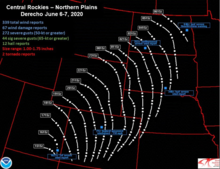Meteorological history

On the morning of June 6, a large trough of low pressure off the West Coast of the United States caused jet stream winds to move from the southwest to the northeast across the Rocky Mountains. A shortwave trough embedded in the southwest flow moved across the Rocky Mountains creating a highly unstable atmosphere and wind gusts between 59 and 71 mph across the state. [5] [6] This caused the Storm Prediction Center to issue slight and enhanced risks of severe weather across much of the North Central United States. [7] At around 9 AM local time a cluster of thunderstorms developed over southeast Utah. Guided by the trough these storms moved northeast and crossed the Continental Divide at around noon. The Rocky Mountains generally disrupt thunderstorm systems but this system was too powerful. [8] The National Weather Service in Boulder issued the largest severe thunderstorm warning it has ever issued covering an area of over 20,000 square miles. [9] The storm moved into South Dakota by six in the evening and dissipated in eastern North Dakota by midnight the next day.